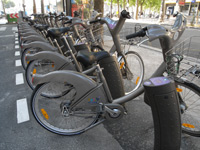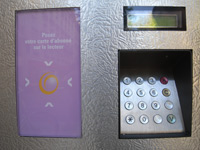


Every Brit knows that the French love their vélos. Whether pedalling
home from the marché wearing a string of onions or struggling up a mountain
in a Lycra body stocking, we picture our continental neighbours as streets
ahead of us when it comes to two wheeled-transport.
In fact, while Paris is home to over two million people, a mere 150,000 locals
own a bicycle. “The rate of cycling here is relatively low,” reveals
Didier Couval, Cycling Officer for the City of Paris. “People ride on
holiday but when they come home, they have no room to store a bike, or don’t
like the noisy, aggressive roads.”
But that’s all set to change, thanks to a high tech community bike system
called Velib (www.velib.paris.fr), launched during the final days of this year’s
Tour de France. Ten thousand bikes were scattered across the city at 750 rental ‘stations’;
at train and Metro stops, on busy shopping streets and near major tourist sights.
Anyone with a Navigo pass (a bit like London’s Oyster card) can simply
swipe it to release a bike, and everyone else can buy day- or week-long passes
(for just a couple of Euros) from an LCD terminal, 24 hours a day. You need
a Chip and Pin credit or debit card to sign up to the system, but the good
news is that short rides are then completely free.
“
Rides of up to 30 minutes are free,” says Didier Couval. “But it
gets expensive if you keep bikes for longer, to discourage people from keeping
them all day. The idea is like a taxi: take the bike for a trip and at the
end it’s free for another customer.”
 Bikes
in a rack in Paris, and the kiosk interface for rental
Bikes
in a rack in Paris, and the kiosk interface for rental 
The system uses digital RFID chips embedded in each bike to track when they’re
rented and returned, anywhere in the city. Each rental station works in eight
different languages (although it does have a habit of returning to French if
something unexpected happens) and even has a built-in hotline to a help centre
where English-speaking staff can sort out problems.
Testing the system in its first week, there were no shortage of these. Some
stations refused to accept UK credit cards, others insisted they had no bikes
when four or more were locked in place, and a few wouldn’t accept bikes
for return. Stations at city centre spots were besieged by riders waiting for
a bike, and those near hotels in the evening were often full, forcing a lengthy
detour to a neighbouring station.
Having said that, zipping along car-free bike lanes by the Seine beats the
Metro for speed as well as style – and another problem with the billing
system meant that I got a weekend’s worth of riding for precisely nothing.
Despite teething issues, Couval considers Velib a success: “The network
has had over a million trips in its first three weeks, and we’re aiming
to double the number of bikes and stations by the end of 2007. Unfortunately,
we can’t always put stations where we want. To protect historic places,
we weren’t allowed stations to interrupt the view on the Champs Elysée
or in the Place du Carrousel in the Louvre.”
Unlike the Tour de France, it’s not recommended to ride a Velib while
under the influence of drugs or drink. Helmets are encouraged but aren’t
available for rent, however crashes in the first weeks have proved rare. “We
only had five small accidents from the first half a million journeys,” says
Couval, “And none required hospitalisation.” That’s probably
partly due to Velib’s tank-like bikes (see box out) that require Lance
Armstrong leg power to reach hazardous velocities.
Couval is certain that Velib will go from strength to strength. “People
are persuaded to cycle when they see others cycling. We’re hoping for
a snowball effect that doubles or triples the numbers of cyclists in Paris.” If
he’s right, in a few months there will be more Velib journeys in Paris
every day than taxi rides. That’s got to be good news for anyone interested
in greener, cleaner cities. And probably for French onion sellers, too.
Built to last
Velib’s bike are rented between 10 and 15 times daily with minimal maintenance,
so no ordinary bone-shaker would do.
•
Overall weight is 22kg – nearly twice as heavy as a normal mountain bike.
• Brakes and gears are located inside a protected wheel hub
• Cables are hidden within the metal frame
• The saddle can adjusted to suit riders of all heights.
• Bright LED lights run continuously while the bike is moving - and for
a couple of minutes afterwards
• A fleet of electric bikes and vans maintain the bikes, which are cleaned
using reclaimed rainwater
• When they finally die, the Velib bikes are 99% recyclable.
Riding around the world
Since the Dutch set up a help-yourself ‘white bicycle’ in Amsterdam
in the 1960s, free and community bicycle schemes have been tried all over the
world. It’s probably just a myth that bicycles were painted white to
make them easier to fish out of canals, but what’s certainly true is
that most schemes were plagued by theft and vandalism. Cambridge’s Green
Bike scheme failed after all 50 cycles were stolen on its very first day. Recently,
successful high tech schemes in Barcelona, Stockholm and Lyons have required
a deposit or subscription, and in 2004 London got OYBike (www.oybike.com),
a pay-as-you-ride system that lets you book bikes by mobile phone.